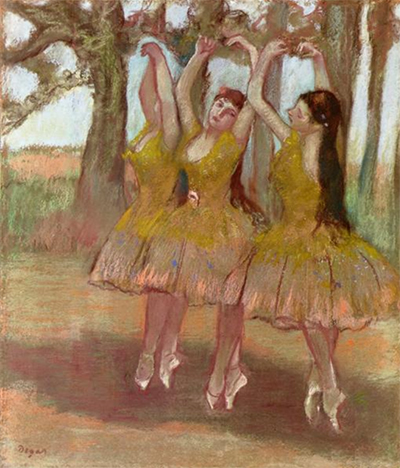No artwork conceived by such brilliant artists in the 19th century can trump the effortless approach conceived by French artist Edgar Degas. The artwork proves a masterful stretch of paint and hand technique that created the beautiful piece. A Grecian Dance. The word 'Grecian' stems from Greek terminology referring to the civilization of Ancient Greece, commonly in regard to its architecture.
The artist of the piece, Edgar Degas, commonly showcased an array of different cultures and their traditional dance. This is evident in the artist's prior painting, Russian Dancers. While the painting illustrates the colourful form of Russian Dancers swaying away In their traditional context, A Grecian Dance pats tribute to Ancient Greece. The viewer is able to witness through the painting the exotic presence of the women compared to Degas' classic characters. The three women within the artwork evidently descend from their Greek heritage based on their characteristics and attire. Their olive skin tone differs from the classic pale characteristics of the ballerinas commonly showcased in the artist's work. Similarity their long flowing hair in red and black contrasts the classic ballerina buns Degas commonly depicted.
Based on this evidence, art history critics believe Degas was influenced by a different muse for the artwork. The artist may have gone to a theatre in France to watch an exotic show from other cultures. A classic practice in France at the time for the upper class, and a fond activity of the artist. Edgar Degas most likely saw the classic Grecian Dance of Greece and was struck by their different form and aesthetic to the French Ballerinas he famously painted. The painting showcases the three figures with their hands above their head as their fingers touch one another. Their hands form a large O as they stand on their tippy toes imitating ballerinas. Their pointed shoes are perceived in a white satin, roughly merging with the ground. All three figures are dressed in mustard yellow dresses that extend into a falling tutu. The dresses expose both the ballerina’s chest and back as they plunge on both sides.
The impressionist technique of Degas to paint the dresses is based in a multitude of different colours filling in the dress. Shades of pink and blue hit the canvas in certain areas, while white seams outline the fabric. The artist used a lighter pink near the bottom of the dresses in salmon colour to bring harmony with the remaining colour scheme of the art work. Additionally, the artist had decided to showcase the folding texture of the skirts as the layers lay upon one another in a bunch. This technique adds extra detail to the artwork with a realist touch of clarity.
The background of the painting is based in an array of pastels that bleed into one another to create a calm environment. The artist does not use any sharp fluorescent colours throughout the artwork and sticks to warm shades. Even the small glimpse of green and brown are based in pastels to add warmth back to the piece. The outside setting of the artwork justifies that indeed the piece is a creation of Degas's imagination as the dance of ballet is not possible in the dirt. Tall brown trees cover the background of the piece, yet with no leaves in sight. A baby blue sky peaks through the branches of the trees onto the ballerina's mystical performance. All of the characteristics of the artwork come together as one with A Grecian Dance, showcasing the impeccable abilities of Edgar Degas as a true forefather of this artistic generation.




